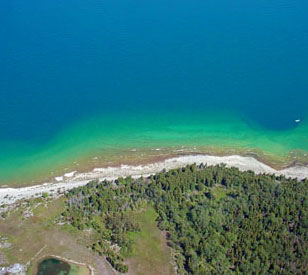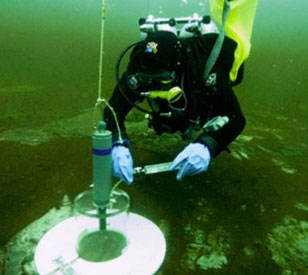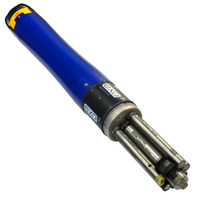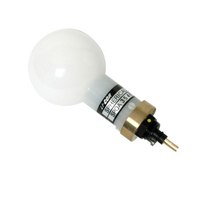 Along the seafloor of Lake Huron, there are several karst sinkhole formations through which groundwater enters the lake bottom and carries with it remnants of an ancient sea.
Along the seafloor of Lake Huron, there are several karst sinkhole formations through which groundwater enters the lake bottom and carries with it remnants of an ancient sea.
A team from the National Oceanic and Atmospheric Administration’s Thunder Bay National Marine Sanctuary and Institute for Exploration first discovered evidence of the sinkholes by accident in 2001 while studying shipwrecks located offshore from Alpena, Mich. Upon measuring unusual levels of conductivity, the team called in Bopi Biddanda from the Annis Water Resources Institute at Grand Valley State University and Steve Ruberg from NOAA’s Great Lakes Environmental Research Laboratory, who both discovered the sinkholes.
Biddanda and Ruberg are part of a research team that has been studying the sinkhole ecosystems since 2003, which also includes GVSU researcher Scott Kendall. The team has discovered that the ion-rich groundwater entering Lake Huron through the sinkholes carries with it dissolved material from 400-million-year-old Paleozoic bedrock. Hundreds of millions of years ago, the bedrock was a seafloor, and it still contains deposits from the ancient sea’s sulfur and salt, according to Biddanda.
Because this water is denser, it forms a layer bathing the lake floor. In this region, microbial mats metabolize sulfates to sulfides and bright purple cyanobacteria photosynthesize the sulfides back to sulfates. Sinkhole microbes are efficiently recycling the sulfur from the venting groundwater. On the lake floor’s surface, microbial mats use available sunlight. Deeper into the sinkholes, though, microorganisms must survive using only chemical means, called chemosynthesis. These organisms, often called “extremophiles,” are typically only seen in deep-sea hydrothermal vents, cold seeps, and frozen Antarctic lakes.
The research team believes the Lake Huron sinkholes provide a unique opportunity to study groundwater intrusion into freshwater habitats. Additionally, they see it as an opportunity to study a snapshot of Earth’s distant past. By examining the sinkholes, they hope to learn the origins of the ancient groundwater minerals; quantify precisely how long ago they were deposited and how rapidly they are flowing into the lake; and map the gradient of water quality from sinkholes to the freshwater above.
In addition to employing divers and ROVs, the research team has worked with NexSens Technology to deploy several sensors and water quality sondes to assess the conditions around three submerged sinkholes in the TBNMS.
Monitoring microbial mats
 YSI multi-parameter water quality sondes have been used to collect discreet and continuous time-series data on the water quality of the groundwater and overlying lake water in the sinkholes.
YSI multi-parameter water quality sondes have been used to collect discreet and continuous time-series data on the water quality of the groundwater and overlying lake water in the sinkholes.
Six standalone YSI sondes were mounted within custom benthic chambers to evaluate microbial mat metabolism over the span of two to three days. They were equipped with sensors for measuring temperature, conductivity, dissolved oxygen, pH, and ORP. NexSens created custom sonde fittings to allow the sondes to mount seamlessly into the chamber housings.
Concurrent to the chamber measurements, a standalone NexSens SDL submersible data logger was equipped with a LICOR LI-193 Spherical Quantum Sensor to measure photosynthetically active radiation at various depths into the sinkhole, thus helping to assess the gradient from the highly irradiated surface water to the more turbid groundwater beneath. The SDL is capable of powering the sensor and operating for extended periods of time running on just eight D-cell alkaline batteries.
Additionally, YSI sondes were used to obtain conductivity measurements at small depth intervals to further define the thickness of the groundwater layer and measure characteristics of the chemocline.
The data from the sondes, along with lab analysis of diver-collected samples, show the venting groundwater exhibits chemistry that significantly differs from the lake’s typical freshwater environment.
The groundwater, characterized as water with conductivity ten times greater than lake water, has a lower temperature (7-9 vs. 4-25 degrees Celsius), lower pH (~7.1 vs. 8.3), higher specific conductivity (~2.3 vs. 0.3 mS/cm), and lower concentrations of dissolved oxygen (0-2 vs. 5-11 mg/L) and nitrate than Lake Huron water. High conductivity of venting groundwater is attributed to concentrations of dissolved sulfate (1,000 mg/L), carbonate, and chloride ions.
With the help of sensor and data logging equipment from NexSens, the research team has been able to gain a deeper understanding regarding the nature of these unique freshwater sinkholes.
The X2-SDL Submersible Data Logger is a rugged, self-powered data logging system with optional cellular, satellite, or radio communications.
The YSI EXO represents the next generation of water quality instruments from YSI. The EXO2 sonde includes six sensor ports and a central anti-fouling wiper option.
The LI-COR LI-193 Underwater Spherical Quantum sensor accurately gives an added dimension to underwater PAR measurements.



